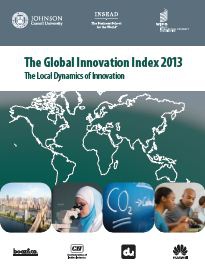 [Swaraj Paul Barooah. Cross-posted from Spicy IP, Link] One would expect that the US Chamber of Commerce would have enough funds to commission a thorough and well researched report whenever they were to do so. Yet, their GIPC IP Index 2014 is what I would call a thoroughly embarrassing example of research methodology, let alone something that can be passed off as a useful “international index”. Is it a coincidence that the report comes up with results that favour some of industries well known for their lobbying in the United States – Big Pharma and the Tobacco lobby being the clearest examples? In this post, I’ll be marking out some egregious examples of flawed research methodology and would encourage readers to either add to my list, or to prove my suspicions of a biased index wrong. While this topic would optimally require a full report on its own, I’ll have to make do with one blog post, so will try to make my points as concise as possible. If anyone would like an expansion on any point, please leave a comment and I’ll do my best to expand on it. [Long post ahead]
[Swaraj Paul Barooah. Cross-posted from Spicy IP, Link] One would expect that the US Chamber of Commerce would have enough funds to commission a thorough and well researched report whenever they were to do so. Yet, their GIPC IP Index 2014 is what I would call a thoroughly embarrassing example of research methodology, let alone something that can be passed off as a useful “international index”. Is it a coincidence that the report comes up with results that favour some of industries well known for their lobbying in the United States – Big Pharma and the Tobacco lobby being the clearest examples? In this post, I’ll be marking out some egregious examples of flawed research methodology and would encourage readers to either add to my list, or to prove my suspicions of a biased index wrong. While this topic would optimally require a full report on its own, I’ll have to make do with one blog post, so will try to make my points as concise as possible. If anyone would like an expansion on any point, please leave a comment and I’ll do my best to expand on it. [Long post ahead]
A crooked frame
 The index, prepared by Pugatch Consilium, whose other clients include several Big Pharma companies and consortiums (See page 15 here), ranks 25 countries based on 30 indicators they’ve chosen. With most of the indicators and respective baselines they’ve chosen to measure the countries on, they seem to have forgotten that IP is a means towards innovation and not an end in itself. Unsurprisingly US tops the list and India is at the bottom. It’s interesting to note the vast differences in the relative positions of the same 25 countries in the much more robust Global Innovation Index (prepared by WIPO, INSEAD and Cornell University using 84 indicators while examining 142 countries – see our SpicyIP post on it here). Of course, the results in themselves aren’t problematic but now comes the fun part – how they’ve arrived at this.
The index, prepared by Pugatch Consilium, whose other clients include several Big Pharma companies and consortiums (See page 15 here), ranks 25 countries based on 30 indicators they’ve chosen. With most of the indicators and respective baselines they’ve chosen to measure the countries on, they seem to have forgotten that IP is a means towards innovation and not an end in itself. Unsurprisingly US tops the list and India is at the bottom. It’s interesting to note the vast differences in the relative positions of the same 25 countries in the much more robust Global Innovation Index (prepared by WIPO, INSEAD and Cornell University using 84 indicators while examining 142 countries – see our SpicyIP post on it here). Of course, the results in themselves aren’t problematic but now comes the fun part – how they’ve arrived at this.
They chose 5 countries from the lower middle income range to compare against 20 countries from upper middle and high income ranges. Then, ignoring the TRIPS Agreement and the WIPO Development Agenda and all other international norms for flexibilities in IP regimes, have, for most indicators used one development-unfriendly baseline (for each indicator) against which all countries, rich and poor, were compared against. The unbalanced selection of countries, in itself, is geared towards encouraging baseless rhetoric rather than any nuanced understanding of how IP regimes interface with innovation. For example, compare the following: “GIPC IP Index ranks India last!” versus “Global Innovation Index: While India ranked 66th out of the 142 countries, it ranked 3rd amongst Lower Middle Income countries, 1st amongst Central and Southern Asia, and 11th in overall efficiency rating.”
Ironically enough, the index itself, on page 9, recognizes that comparing countries (regardless of development or income) and relying on correlation is not statistically robust, yet goes on to use this country comparison data as the major highlight of its report! (See their website for instance).
Scoring methodology
A robust innovation index. Click here for a quick infographic.
Each of the 30 indicators is given 1 point each. An inordinate amount of the patent related indicators are dedicated solely towards pharmaceutical products (5/7) without any explanation as to why over 70% (5/7=0.714) of a country’s patent regime is being judged based on (biased) pharmaceuticals as opposed to the countless other industries that IP regimes affect. While they haven’t gone into why they’ve chosen the baseline they have for most indicators, they did throw in this one line that makes it amply clear that there is a big problem in mysterious ways that they’ve chosen baselines:
“Where no adequate baselines are found in international law or treaties, the baseline values are based on what rights holders view as an appropriate environment and level of protection”.
They have not mentioned when an international norm is deemed as “adequate” or inadequate. They have not mentioned nor appreciated anywhere the fact that an IP regime has more than one party’s interests involved in it.
Two of the thirty indicators are binary indicators. Meaning that a country can either get 0 or 1 on it. These two indicators relate to a) Compulsory licenses and b) restrictions on the use of products in packaging of different products (trademarks).
a) Compulsory Licenses. They have listed 4 criteria regarding compulsory licenses. Of these 4, only one is clearly required by TRIPS – the existence of adequate and well defined recourse mechanisms for parties affected by the issuing of a license. The other three criteria are TRIPS plus guidelines, i.e., resulting in a constriction of flexibilities of countries. Yet if a country doesn’t fulfill any one of these four, it gets a 0 on this indicator. There is no reason given for why these 4 criteria have been chosen, or why this needs to be a binary indicator when there are clearly more than 2 factors involved.
b) Restrictions on the use of brands in packaging of different products. It seems somewhat silly to point out that Trademarks cover more than tobacco products – especially when the title of the indicator says “of different products”. Yet, this is a binary indicator, with only 2 out of the 25 countries (Turkey and Australia) getting a 0 instead of a 1 on this. The only restrictions that these 2 countries have introduced is that of plain packaging requirements for tobacco products – in furtherance of a public health policy. Yet, this manages to ensure that these two countries get a complete 0 on this indicator.
From here till infinity!
 In their indicator for duration of Copyright lengths, they have said that they are using US’ minimum copyright period of 95 years as the baseline. Firstly, as a general rule, US’ minimum copyright period is 70 years (plus life of author), not 95 years. It is 95 years for works for hire. Did the authors forget that non-corporates also create works?
In their indicator for duration of Copyright lengths, they have said that they are using US’ minimum copyright period of 95 years as the baseline. Firstly, as a general rule, US’ minimum copyright period is 70 years (plus life of author), not 95 years. It is 95 years for works for hire. Did the authors forget that non-corporates also create works?
But, arguably the best example of flawed methodology manifests in this indicator. The index determines a countries score by dividing their copyright term by 95. The problems this raises:
- No reason is given as to why the TRIPS norms of life of author plus 50 years is not used as the norm. Most countries allow minimum terms of between 50-70 years. This has been completely ignored and US’ corporate works term has been randomly selected as the “baseline”
- Copyright terms are of a limited duration for a very good reason. Because unlimited monopolistic terms are bad for society and harm creativity and dissemination of knowledge. This index, not only doesn’t recognize this, but is designed in such a way that if a country hypothetically allowed an eternal copyright term, it would be rewarded with a score of infinity on the IP index thus topping the whole index as well!!
- On a less rhetorical note, it would also give a score of higher than 100% (i.e., higher than 1/1) if any country had a minimum term of higher than their “baseline” of 95 years. Methodology flawed much?
Redundancy or Subterfuge?
Should these tactics still work?
And finally, after several not so subtle mentions of encouraging the super controversial Transpacific Partnership Agreement the 30th indicator gives a point for countries that have signed “At least one free trade agreement with substantive and/or specific IP provisions such as chapters on IP and separate provisions on IP rights provided it was signed after WTO/TRIPS membership”.
Once again – no reason is given for why this would be important or relevant to anything in an IP index. Assuming the best of intentions, this would be a completely redundant indicator, given that most if not all substantial IP provisions have just been ‘graded’ in the previous 29 indicators. So it would, by proxy, be giving double positives or double negatives to countries for IP provisions they have already been ranked on – clearly a flawed method of scoring.
Assuming the worst of intentions, this would be a clear pressure tactic to push countries into signing some of the anti-innovation bilateral and multilateral “free trade” agreements that include very hostile IP provisions. These have become so common and problematic that the Max Planck Institute put together a set of “Principles of IP Provisions in bilateral and regional agreements” to help counter the continuous push of corporate lobbies in pressuring countries into accepting hostile IP provisions. In fact, in the graph given on page 36 of the GIPC Index, they have specifically mention “TPP Negotiating Countries” despite negotiations being given no points. I can only assume they’re not so subtly hinting that signing the TPP would give them points on the next edition of this IP index.
Conclusion
With the number of flaws present in this index, it seems silly to spend any time on taking it seriously. However, one needs to remember that this is a US Chamber of Commerce (USCC) report – thus automatically granting it a fair amount of ‘credibility’. And this report will now likely be used to base many more of their allegations against India. The USCC GIPC Vice President Mark Elliot, was listed as one of the witnesses scheduled to appear at the USITC hearing on “Trade, Investment and Industrial Policies in India: Effects on the US Economy”. The US Chamber of Commerce has also requested that India be categorized by the USTR as a Foreign Priority Country – a designation given to the worst IP offenders and which could result in trade sanctions. While such reports and allegations continue to come in, it’s not surprising to see that action isn’t being taken at the WTO forum, which optimally should be the best place to sort out such disputes. Unfortunately though, the WTO forum may provide too much of a balanced forum for such allegations to hold ground – something that evidently hasn’t been lost on the complaining parties. There seems to be a bigger push on focusing on the perceptions that lobbyists want to perpetuate rather than looking at actual international norms and facts.
[And to save time with regard to the critical comments that always come with posts such as this – we would be more than willing to put up guest posts by anyone who wants to claim there is something wrong with my assertions here – so please engage your brickbats productively!]






